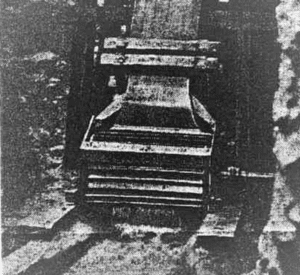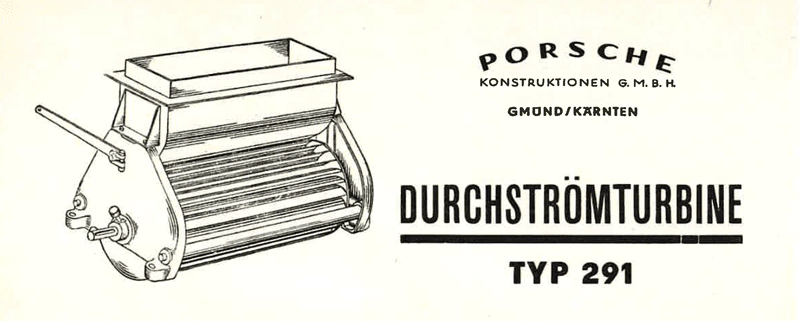Original 1949 Porsche Konstruktionen GesmbH (Gmünd) water turbine now in fahr(T)raum
In the years between 1944 and 1950, the Porsche works in Gmünd/Carinthia, which operated under the name Porsche-Konstruktionen-Ges.m.b.H., produced not only the Porsche 356 No. 1 Roadster but also designs for racing cars, tractors, cable winches, ski lifts and crossflow turbines.
The Type 291 crossflow turbine – on loan from the Porsche Automuseum in Gmünd – is currently on exhibit at fahr(T)raum. “We have been working together with the Porsche Museum in Gmünd for a long time and have a very strong and dear partner in the Pfeifhofer family,” says Jakob Iglhauser, Managing Director of the fahr(T)raum classic car museum in Mattsee near Salzburg.
 The turbine was used, inter alia, to drive sawmills, mills and agricultural machinery. It was also used to generate electricity. The advantage over the traditional water wheel was the significantly higher speed of the turbine, with which a higher output – even with a smaller water volume – could be achieved. The nozzle could be regulated by hand. The turbine was recommended for the “economic utilisation of small hydropower plants” for a power output of 4 to 20 HP for a fall height (drop) of 2.4 to 6 metres or a power output of 40 HP for a drop of 10 metres. It consists mainly of sheet steel parts welded together, the impeller runs on ball bearings. According to the original instruction handbook, maintenance is limited “to daily retightening of the lubricators provided on the bearing bodies and refilling these lubricators with grease after a longer period of operation.”
The turbine was used, inter alia, to drive sawmills, mills and agricultural machinery. It was also used to generate electricity. The advantage over the traditional water wheel was the significantly higher speed of the turbine, with which a higher output – even with a smaller water volume – could be achieved. The nozzle could be regulated by hand. The turbine was recommended for the “economic utilisation of small hydropower plants” for a power output of 4 to 20 HP for a fall height (drop) of 2.4 to 6 metres or a power output of 40 HP for a drop of 10 metres. It consists mainly of sheet steel parts welded together, the impeller runs on ball bearings. According to the original instruction handbook, maintenance is limited “to daily retightening of the lubricators provided on the bearing bodies and refilling these lubricators with grease after a longer period of operation.”
The turbine was produced in two types – type 291/1 (490 kg, max. height 760 mm, max. length 1250 mm) and type 291/2 (390 kg, max. height 740 mm, max. length 750 mm). The purchase and installation of the turbine was affordable even for economically weak mining operations.
Originally, the crossflow turbine was invented as early as 1903 by Anthony George Michell in Melbourne. Improvements were first made by Professor Donat Bánki from Budapest and later by Ing. Erwin Sonneck.
How does the water in the crossflow turbine work? The answer to this question, as well as further technical details on how the turbine works, can be found in the current classic car exhibition at Ferdinand Porsche’s worlds of experience fahr(T)raum !







NEW at fahr(T)raum: Steyr Type 30 Cabriolet (1931)
/in Geschichte, Non categorizzato, Sonstige FahrzeugeFerdinand Porsche, who has gone down in history as a pioneer of automotive engineering, developed a car for the upper middle class for the Steyr-Werke in 1929: following his career as Technical Director at Austro Daimler (1906-1923). He very advantageously reengineered, as instructed by Steyr, the Steyr type XX and created a substantially new model […]
Now on exhibit at fahr(T)raum: the world´s only Austro Daimler ADV Boat Tail!
/in Geschichte, Non categorizzato, Sonstige FahrzeugeThe last design which Ferdinand Porsche engineered as technical director for Austro Daimler is now on display at fahr(T)raum Mattsee: the Austro Daimler ADV Boat Tail. It was built in Wiener Neustadt in 1923, but it received its unique chassis – the “Boat Tail” – in the 1950s in the USA. The ADV is a […]
New exhibit at fahr(T)raum – 1916 Austro Daimler 2-cylinder Feldbahn engine
/in Geschichte, Motoren, Non categorizzatoField and industrial railways (Feldbahnen) have assisted the transport of agricultural, forestry and industrial raw materials and products since the 19th century. They offered high transport performance with simultaneous low energy consumption (low rolling resistance of the wheel-rail system). Their use is mainly associated with the processing industry, such as, e.g., chamotte or sugar factories […]